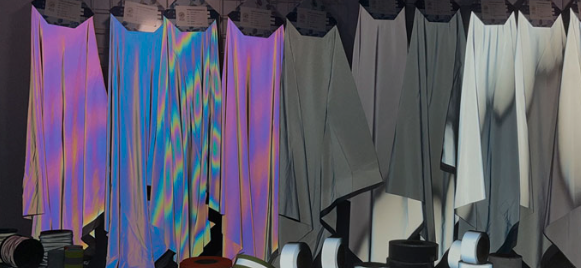Revolutionizing Textiles: A Deep Dive into Thermochromic Fabrics

In the ever-evolving world of textiles, thermochromic fabrics have emerged as a groundbreaking innovation, seamlessly blending technology with fashion. These fabrics undergo color changes in response to temperature variations, opening up a realm of possibilities for dynamic and interactive designs. This comprehensive exploration will delve into the science behind thermochromic fabrics, their applications, manufacturing processes, and the future they hold in the textile industry.
Understanding Thermochromism
The Science Behind the Magic
At the core of thermochromic fabrics lies the fascinating science of thermochromism. These fabrics contain pigments or dyes that undergo a reversible color change when exposed to fluctuations in temperature. This phenomenon is rooted in molecular rearrangements, providing a dynamic visual display that captivates the beholder.
Types of Thermochromic Materials
Thermochromic fabrics utilize a variety of materials, including liquid crystals, leuco dyes, and other innovative compounds. Each material type exhibits unique characteristics, influencing the final appearance and performance of the fabric. Understanding these variations is crucial for designers and manufacturers aiming to harness the full potential of thermochromic textiles.
Applications Across Industries
Fashion Forward: Thermochromic Textiles in Apparel
From high-end fashion runways to casual streetwear, thermochromic fabrics are making a bold statement in the world of apparel. The ability to change color with temperature variations adds an element of surprise and interactivity, creating unique and attention-grabbing garments. Fashion designers are increasingly incorporating these fabrics into their collections, offering consumers a blend of style and technological innovation.
Beyond Aesthetics: Thermochromic Fabrics in Functional Wear
The utility of thermochromic fabrics extends beyond aesthetics. In the realm of functional wear, such as sportswear and outdoor gear, these textiles play a crucial role. Temperature-sensitive color changes can indicate variations in body temperature, helping athletes monitor their physical exertion levels. Additionally, thermochromic fabrics can enhance visibility and safety in low-light conditions.
Interior Design and Beyond
The impact of thermochromic fabrics is not limited to the realm of wearable textiles. Interior designers are embracing these innovative materials to create dynamic and mood-enhancing spaces. Thermochromic textiles applied to furniture, curtains, and wall coverings can transform the ambiance of a room, offering a sensory experience that goes beyond the visual.
Manufacturing Marvels
The Production Process Unveiled
Manufacturing thermochromic fabrics requires a delicate balance between traditional textile processes and cutting-edge technology. The incorporation of thermochromic pigments or dyes demands precision to ensure the final product meets both aesthetic and functional requirements. Understanding the intricacies of the production process is vital for achieving consistent and reliable thermochromic effects.
Challenges and Innovations
As with any revolutionary technology, the production of thermochromic fabrics comes with its set of challenges. Ensuring color stability, durability, and wash resistance are key concerns that manufacturers are actively addressing. Innovations in material science and production techniques are paving the way for thermochromic textiles that meet rigorous industry standards.
Future Perspectives
The Road Ahead: Advancements in Thermochromic Technology
The journey of thermochromic fabrics is far from over. Ongoing research and development efforts are focused on pushing the boundaries of what these textiles can achieve. Advancements in nanotechnology, improved pigments, and enhanced manufacturing processes are poised to elevate thermochromic fabrics to new heights, unlocking even more creative possibilities.
Sustainability in Focus
In a world increasingly conscious of environmental impact, the sustainability of thermochromic fabrics is a pertinent consideration. As the textile industry pivots towards eco-friendly practices, researchers are exploring ways to develop thermochromic textiles with minimal ecological footprint. Sustainable sourcing of materials and recyclability are becoming integral aspects of the evolving landscape of thermochromic fabric production.
Conclusion
In conclusion, the fusion of thermochromic technology with traditional textiles has given rise to a dynamic and transformative category of fabrics. From the runway to everyday wear, and from interior design to functional gear, thermochromic fabrics are leaving an indelible mark on diverse industries. As we navigate the ever-evolving landscape of textile innovation, the future holds exciting possibilities for thermochromic fabrics, promising a colorful journey into the intersection of fashion, technology, and sustainability.




